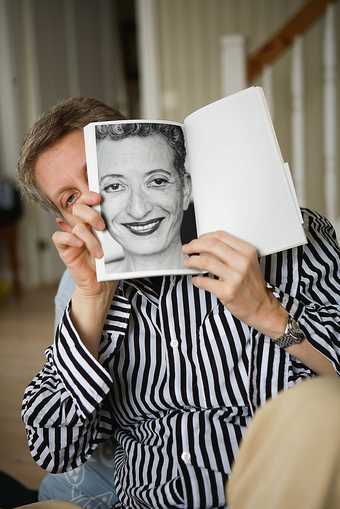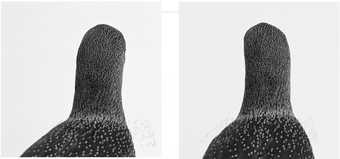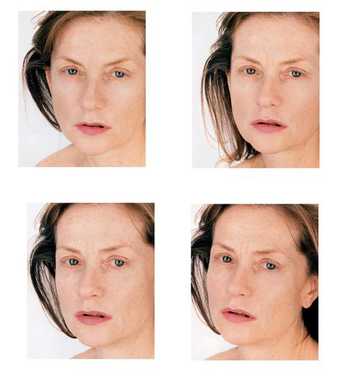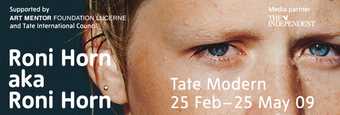
Roni Horn
This is Me, This is You 1998–2000
C-type prints
Two panels of 48, each 31.7 x 26 cm
Courtesy Hauser and Wirth, Zurich © Roni Horn
A writer-philosopher-poet-theoretician who is incidentally a woman but also defines herself beyond the binary dichotomies of gender – what does she look like? And is that really the purpose of Index Cixous, the book that Roni Horn published in 2005? Does this little book with no text actually suggest the portrayal of a person’s appearance? The quality of the 80 photographs contained in this volume, with the format 14 × 20.5 cm, lies in its shattering of any attempt at a monofocal representation of “Hélène Cixous, the famous writer”. They don’t display the style, the label, the stamp of a photographer scratching beneath the mask in search of a truth. Instead they melt those identities, as we might speak of the melting of snow or a glacier, of a place, that is, that is being changed by time. The name of Cixous is alone in the list of meaningful terms to which the pages refer. Index Cixous lays out a frontal relationship and a frontal exchange – your face against someone else’s – which liquefy certainties in order to reinforce the experience of reading, the “fruitful miracle of a communication in the depths of solitude”, as Proust puts it, along the paths of an adventurous, agnostic repetition of what presents itself as the meaning of the read text.
Framed by a white border, the face follows on from itself on the different pages of the bound and unpaginated book. That face is always shown in close-up, leaving out the top of the head, which places it at odds with any respect for pre-established delimitation. It is hardly ever shown face-on, seldom in full profile: the expressive duality that the art historian Meyer Schapiro has turned into a symbolic form (that of the face and the profile, the divine and the concrete, the icon and the medal…) never reaches the end of this tale. Sometimes there are two faces on adjacent pages; one on the left and the other on the right; or one recto, the other verso. Sometimes they form groups or come together in sequences. Sometimes there is only one face and a blank on the page next to it; to the left or the right, as if to begin or end a sentence. The pictures are in black and white and about a fifth of them are in colour. Punctuation marks, rhythms and sets thus construct a system of signs that supports and carries the reading. A blank. A smiling face. A blank. A smile. A smile stretching into a laugh. A laugh fading away and lasting in the movement that calms the features. A blank. The face looks elsewhere. The face is absorbed. The head inclines. Blank. Blank. She thinks. She listens. She reads… Identity is diffracted in a multiplicity of representations which in turn index motions and construct a seismograph of emotions. Index Cixous suggests a rhythm, a temporality, sequences and silences that are the music of reading. Like the gestures of a conductor, the layout, head turned to the left, then to the right, largo, legato, staccato, andante, executes the notes and cadences for which the book is also the score. It is also to say how much photography, when it is “laid out in a book”, loses its cult, autographical status to settle within your reach.
When she isn’t looking at you, her eye marked by your absence with the ghostly clouds of the flash, Cixous is looking elsewhere, downwards, off-camera. That’s what the face, the gaze, the smile, the tension in the lips, the tightening of the mouth or its relaxation inscribe in the body of the image: the other field, of reading, of writing, of the word and of listening and also of their suspension. The other field, which invites us to deduce that the body is in a seated position, that of reading and of writing and of their exchange. Ingmar Bergman began Die Zauberflöte with the vision of children, seated, listening: an announcement. The Annonciation: seated, reading, the Virgin listens. Art consists of making a mute relationship heard.
Every image is run through with tensions. It is subject to the vacillation of its meaning, which it moves while moving you. The image, according to the historian Aby Warburg, far from being fixed and closed in on itself, has the task of capturing the origin of things, the movement of their origin and their unfolding in time, while constantly colliding with other images in order to spill off camera. In Roni Horn, it is both metonym and metaphor. Thus we can recall the history of photography and the moment when, with Etienne-Jules Marey, in about 1882–9, it broke up the movement of the body across which it passed, revealing spectral forms, traces of passage. Thus we can summon the textual flux, the alluvial richness of Hélène Cixous’s writing. Thus we can evoke her constant exchange with Jacques Derrida, two writers mobilising resources, ways of reading, devices of writing, which while they are different, still granted one another an unconditional hospitality and reception. Similarly, Roni Horn and Hélène Cixous have engaged to produce an oeuvre, less “collaborative” (the term seems to have the value of a system) than respectful and at the same time curious, of the movements of the other. Cixous replied to Roni Horn’s invitation to react to the titles of all of her previous works with Wonderwater (Alice Offshore) in 2004, with Louise Bourgeois, Anne Carson and John Waters. She wrote “How to translate ‘the intangible’ without touching it?” on the occasion of Roni Horn’s 2004 exhibition Rings of Lispector (Agua Viva). The artist took the words of the Brazilian author Clarice Lispector, translated by Cixous, and printed them on a rubber floor so that they looked like they were rolling, curving and making somersaults. Then, in May 2008, Cixous gave a talk where she unrolled the rapid current of her words amid the glacial waters of Roni Horn’s Library of Water in Iceland. Index Cixous is part of this arrangement of reciprocal listening and seeing. Let’s get back to the book. Under the title one finds an inscription: Cix Pax. Pax is the Latin word for peace, but in it one can also hear the much more colloquial expression: six packs. Between the artist and the other – the other artist, the spectator, the addressee – there is no longer war. There is Cix Pax.

Roni Horn holding up a page from her book Index Cixous (Cix Pax) 2005
Courtesy Roni Horn
Index Cixous isn’t the first photographic work by Roni Horn to flick through page after page, to map image after image, a single face. In 1994–6 the installation You are the Weather presented on a horizontal strip, or assembled in a book, 100 photographs of Margrét Haraldsdóttir Blöndal immersed in the weather of Iceland, its climates, its geography, its lights, its fogs, its baths and hot, cold, tepid, icy springs. This work is often cited as evidence of the long relationship, both real and transferential, that Horn has had with Iceland since 1975. Unlike Index Cixous, Margrét constantly holds the viewer’s eye. “Could it be that the young woman is reacting to the heat, to the cold, to the tepidness, the ice of your gaze? Her shivering flesh embodies you, in the second person, as her gaze is addressed to you and seems to tell you a hundred times, ‘what do you expect of me?’,” Thierry de Duve asks. For the art historian, this address, this “second-person” logic pursues the modern dissemination of the artist’s authority, when the “words talent, virtuosity, imagination, self-expression no longer hold sway”. The book This is Me,This is You, after the installation of the same name at the Dia Foundation in New York 2001, presents 96 images of Georgia Loy, the niece of Roni Horn, who produced the title and the dedication, “to everyone”. Without a chronology, without a narrative drive to give one one’s bearings, not even the irreversible growth from childhood towards adolescence during the two years in which Georgia was photographed, the variation in her features and expressions has no other meaning than that of reading. But as exegetes have noticed, there is not the same anxiety in Georgia’s wise and playful gaze. Aware of addressing someone who is looking at her beyond the familiar lens, she plays and plays with the conventions of the portrait, in the complicity of the stated “me” and “you”. Indirectly addressing the one who is looking, the image inverts that gaze and turns it back towards the photographer, not as a person, but as an event, as an act.

Roni Horn
Untitled, No.4 1998
Two Iris-printed photographs
55.9 x 55.9 cm
Courtesy Hauser and Wirth Zurich © Roni Horn
With Portrait of an Image 2005 Horn likewise seems to capture in a photograph the “event” of the actor, by challenging her part, her very capacity for representation. To this image she has given a face: that of Isabelle Huppert, the internationally famous actress. She owes her celebrity less to her glamour than to her reputation for “minimalism”, characterised by a certain autism towards the person looking at her (Huppert has even spoken of “resistance” towards the director). She has been described as an edgy actress – at once whole and reserved, presenting her body as a white page, or rather a carte blanche, while maintaining a secret interiority. Here, because there was acting at play, the rule consisted in Huppert revisiting with her face, during each session, a role that she played in one of her films, matched with a first name. Does the actress’s function not lie in spreading herself across a series of names? Whether it be Erika (The Piano Teacher, Michael Haneke, 2001); Lena (Coup de foudre, Diane Kurys, 1983); Claire (La vie moderne, Laurence Ferreira Barbosa, 2000); Charlotte (Signé Charlotte, Caroline Huppert, 1984); Dominique (L’École de la chair, Benoît Jacquot, 1998); Jeanne (La Cérémonie, Claude Chabrol, 1994), Mika (Merci pour le chocolat, Claude Chabrol, 2000), Isabelle (Sauve qui peut (la Vie), Jean-Luc Godard, 1980), Marie (Une affaire de femmes, Claude Chabrol, 1988); Emma (Madame Bovary, Claude Chabrol, 1991); Pomme (The Lacemaker, Claude Goretta, 1977). With these films, rather remote in time, and at most nearly 30 years apart, the “actor’s paradox” will have constituted an exercise of memory. “For each role it was a matter of finding an axis, a gaze, a precise expression, an attitude, a feeling which belongs to that role,” Huppert explained some weeks after those sessions in 2005, implying unreservedly in this self-reflective task that the implied “self ”, re-created or rather frozen by the photograph, was that of the character, perhaps also that of the actress and not only – or not at all – that of the person. Speaking of these mnemonic gymnastics, Horn has apparently talked of an act of “self-impersonation”, implying a mise en abyme of the performance process, a process of self-narration and exhibition, in the course of which the actress constructs a temporary identity, a way of showing herself without referring to a central core, a prescribed genre. Much better than that of the self-portrait, the notion of self-impersonation actually refers to a photographic performativity which allows to set out, with the representations produced, an open and perhaps indefinable visual relationship.

Roni Horn
Detail Portrait of an Image (with Isabelle Huppert) 2005
100 photographs in twenty sequences of five
38 x 31.75 cm each
Courtesy Hauser and Wirth Zurich © Roni Horn
The notion of photographic performance created the possibility of making visible and viable alternative representations to those of the dominant culture. This applied, between the first decades of the twentieth century and 1954, to the photographic performances of Claude Cahun, or, to put it more accurately, the fruit of the collaboration between Cahun and her lover Marcel Moore, one as performer/ actress, the other performing as the photographer. This comparison is an interesting one because in the multiple images of Isabelle Huppert (who has also built up a veritable collection around her own image), the collaboration invalidates the usual functions of commemoration or classification generally devoted to photography. Similarly, they have to do with a theatricality that displays a destabilisation of identity, which is all the more formidable when the work concerns the performance of the actor – a notion that blurs a little further the boundaries between public character and private person. Since the project requires Huppert to try to recall and construct several distinct modes of appearance for her image, it is in return exposed to repetition and serialisation, and hence to greater indeterminacy. The panoramic horizontal “line”, formed by the resemblances of five faces side by side and their proximity to another series, pushes still further the limits and the closure of this production process. Perhaps it is simply a system of signs that is finally exposed, a language: the language of performance, in its mere relation to a viewer.
What is an open work? It is not an appeal for the beholder to come along and complete the picture. It is more of an assemblage, which in its exhibition (or in the demonstration of its working) still leaves room for that which is unpredictable and which therefore works towards undoing. This is also how Leonardo da Vinci used clouds: like a blur escaping the clutches of the boundary, which wrong-foots the characteristic bond in Western culture between art and geometry. To demonstrate by experience the structuring of the field of vision, optical machines – such as those used by Brunelleschi to reveal the projective coincidence of point of view and vanishing point – forever collected within themselves the transitory, the volatile, “the wind that drives the clouds”. This is not to celebrate their purity or transcendence, but to inscribe that openness as theory, as the art historian Hubert Damisch put it in 1972: “The cloud is this phenomenon – this phenomenon, not this object – which escapes both all intentional design and every essential position, and has no reality but the accidental and the transitory, for it is made of strictly external causes and conditions, all freedom also being left to the viewer to project his fantasies upon it.” To open up the possibility of being undone is also to remain open to a future of ourselves, which we do not know.


